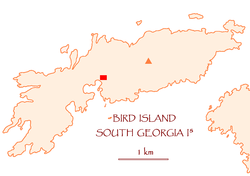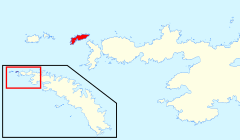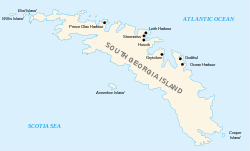Difference between revisions of "Bird Island, South Georgia"
m |
|||
| Line 5: | Line 5: | ||
|picture=Bird-Island.PNG | |picture=Bird-Island.PNG | ||
|picture caption=Bird Island with the BAS station and Roché Peak | |picture caption=Bird Island with the BAS station and Roché Peak | ||
| − | |map=Bird- | + | |map=Bird Island - west end of South Georgia.svg |
|map caption=Location of Bird Island | |map caption=Location of Bird Island | ||
|latitude=-54.0167 | |latitude=-54.0167 | ||
Revision as of 15:29, 7 June 2020
| Bird Island | |
 Bird Island with the BAS station and Roché Peak | |
|---|---|
| Location | |
| Location: | 54°1’0"S, 3°3’-0"W |
| Highest point: | Roché Peak |
| Data | |
Bird Island is an island separated from the western end of South Georgia by Bird Sound. The island is 3 miles long and 900 yards wide,
Contents
History
It was discovered in 1775 by a British expedition under James Cook, who so named it "on account of the vast numbers [of birds] that were upon it".
In the late 1950s, the island was the subject of a number of projects funded from the United States. Between 1959 and 1962, a great number of the island's wandering albatross were ringed, which gave startling data about their range - one bird was found in Australia.
The island has been a station for Antarctic research since 1963, and is currently a biological research station of the British Antarctic Survey, Jordan Cove, with 4 resident biologists. The main focus of the research is the ecology and population of the island's seabirds and seals.
Throughout the Falklands War of 1982, Bird Island remained in British control notwithstanding the Argentine occupation of South Georgia. The British Magistrate and other civilians and military present in Grytviken were removed from South Georgia during the occupation, but another 15 Britons remained beyond Argentine reach. The losses the invaders suffered in their attack on Grytviken prevented them from occupying the rest of the island, so that Bird Island base, and field camps at Schlieper Bay, Lyell Glacier and St Andrews Bay remained under British control.
Bird Island is currently a Site of Special Scientific Interest, and so there are no landings allowed without permission.
The summit of the island, Roché Peak is named for the British sailor Anthony de la Roché who discovered South Georgia in 1675.
2008 marked the 50th anniversary of biological research on Bird Island.
Wildlife
The island is home to:
- 65,000 Antarctic Fur Seals (around 1 for every 6 square yards of the island)
- 50,000 Macaroni penguins
- 15,000 pairs of black-browed albatross
- 12,000 pairs of grey-headed albatross
- 1000 pairs of wandering albatross
- 500 pairs of southern Giant Petrels (10% of South Georgia's total)
In addition to the birds listed above the isle has several hundred thousand other birds, including Gentoo Penguins, South Georgia Pintails and South Georgia Pipits. Of South Georgia's 31 breeding species, 27 are found here.
The island is rat-free, unlike the main island of South Georgia.
Outside links
References
- Stonehouse, B (ed.) Encyclopedia of Antarctica and the Southern Oceans (2002, ISBN 0-471-98665-8)
| South Georgia and the South Sandwich Islands | |
|---|---|
| South Georgia: | Annenkov Island • Bird Island • Clerke Rocks • Cooper Island • Grass Island • Kupriyanov Islands • Pickersgill Islands • Saddle Island • Shag Rocks • South Georgia • Welcome Islands • Willis Islands • Trinity Island • Grassholm • Black Rocks • Black Rock |
| South Sandwich Islands: |
Bellingshausen • Bristol • Candlemas • Cook • Leskov • Montagu • Saunders • Thule • Vindication • Visokoi • Zavodovski |

